Peter MALONE
Saturday, 09 October 2021 13:01
Agatha Crhistie's Poirot Underdog
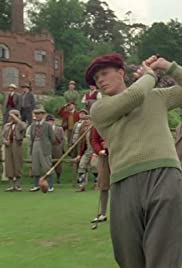
THE UNDERDOG
UK, 1993, 50 minutes, Colour.
David Suchet, Hugh Fraser, Pauline Moran, Ann Bell, Adie Allen, Dennis Lill, Johnny Phillips, Bill Wallace, Ian Gelder.
Directed by John Bruce.
This is a topical 1936 mystery, English laboratories, synthetic rubber, deals with Germany, German rearmament. The film focuses on laboratories, the rather lavish laboratory complex, the mansion owned by Sir Reuben, the manager of the factory, a philistine in terms of art (with a collection of Belgian sculptures that Poirot wanted to look at), arrogant, the archetypal capitalist. His wife is a former actress whom he looks down on. He wants his nephew to work with him but the nephew does not want to. His partner is his younger brother whom he dominates.
Poirot and Hastings go to dinner after Hastings plays golf (after so much talk about this in other films) with the nephew. Later, Sir Reuben is murdered in his home-office.
The initial focus is on the scientist at the laboratory, German connections, working for Sir Reuben, invited to the dinner. There is also the mysterious assistant, falling foul of Sir Reuben after she searches for documents in his desk. She has a brother who is revealed to be a scientist whose formula has been stolen and his sister trying to restore it to him.
The nephew, drinking after the golf match, discovers the body and runs. Poirot assembles everybody, eliminating various aspects – and finally reveals the scientist as the guilty party.
1. The popularity of Agatha Christie mysteries? The television series with David Suchet as Poirot?
2. The 1930s setting, London, laboratories, deals with Germany, German rearmament? Financial deals? Sir Reuben’s home? Interiors? The musical score?
3. Poirot and his office, Miss Lemon and trying to hypnotise Poirot? And Hastings – and his perfect golf hit? Hastings and his opportunity to play golf? Sir Reuben and his Belgian art? Poirot wanting to see it? Sir Reuben as a philistine interested only in money?
4. The laboratory, the letter from Germany, Trufusis and his work, the invasion and the setting the lab fire? Sir Reuben’s anger, rebuilding? The documents, rubber, its use? Profit?
5. The golf tournament, Hastings playing with Sir Reuben’s nephew, the aftermath, the drinking?
6. The household, Sir Reuben and his office, his treatment of his wife, her past acting career, his despising of his nephew, yet wanting him to work in the company, the refusal? Sir Reuben and his brother, partners in the firm, his domination? The brother against the deals with Germany?
7. Poirot and Hastings, the visit, Poirot’s disgust? The return, the death of Sir Reuben? The visualising of the evening, the various visitors to the dinner, the hostile discussions about Germany? Sir Reuben in his room? Those who visited? Charles, the discovery of the body, the blood, his running, his being captured, in jail?
8. The range of suspects, Lily, the rendezvous in the garden, tearing her dress, Poirot with the piece of dress? The documents?
9. The possibility of so many killing Sir Reuben? The person hiding behind the curtain? Sir Reuben’s wife and the hypnotism? Poirot going round the characters, Lily’s brother at the hotel, the revelation about the stealing of his documents, Lily stealing them back, the company profiting by them? His not being the murderer? The elimination of Charles? Sir Reuben’s wife? Lily?
10. The scientist, his role in the laboratory, his contacts with Germany, his being at dinner, retiring early – and his hostility towards Sir Reuben, his work, financial deals, the villain?
Published in Movie Reviews
Published in
Movie Reviews
Saturday, 09 October 2021 13:01
Mr Soft Touch
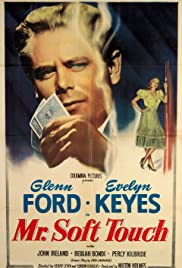
MR SOFT TOUCH
US, 1949, 93 minutes, Black and white.
Glenn Ford, Evelyn Keyes, John Ireland, Beulah Bondi, Percy Kilbride, Ted De Corsia, Stanley Clements.
Directed by Gordon Douglas, Henry Levin.
Mr Soft Touch is one of those pleasant comedy dramas that the studios produced in the late 40s and early 50s with such popular stars as William Holden and Glenn Ford.
This film has two directors, Gordon Douglas who directed comedies and musicals, later tough dramas, and Henry Levin who directed a whole range of films in his career. The film has a gangster theme but is also, as indicated by the title, a rather softer comedy side.
The action takes place around Christmas, Glenn Ford playing Joe, a decorated veteran of World War II, robbing a club that he had founded but which had been taken over by gangsters. He plans to sail from the United States. However, he has to wait two days, tries to spend the time in prison to avoid pursuit, encounters a young woman working at the house for homeless (Evelyn Keyes) – and some tough kids, Beulah Bondi as one of the helpers, Percy Kilbride doing a kind of Pa Kettle as an eccentric border..
Mr Soft Touch is a do-gooder and provides a whole lot of amenities for the homeless. There is a blend of romance, pursuit by gangsters, shooting. Pleasant, and an unusual Christmas drama.
1. The title? The emphasis on the soft touch? And the contrast with the action of the film, harder touches? The combination of both? The role of having two directors?
2. The New York setting, the late 1940s, the post-war atmosphere, clubs and gangsters, robberies, car chases, the contrast with the outreach for the homeless, the accommodation, offices? The musical score? The atmosphere of the times?
3. The introduction to Joe, the extensive initial chase, the bridge and the toll, pursuit, escaping? Filling in the background of his war service, his loss of the club, the takeover? The death of his partner? His going to the home, support from his partner’s brother, his wife? The arrival of the police – and the humour of the charge of ringing the bell? The wife getting the ticket for the boat? Joe and his having to lie low, trying to get himself arrested with the bell? The police treatment, giving him a chance, Jenny and her intervention, his going to the centre?
4. The Christmas atmosphere of the story? The tree, the young men cutting down the tree in the park? The decorations and Joe helping? The carols? The gifts?
5. Joe, the soft touch, helping with the decorations, the further charity, getting the towels and the bedding, the baths? His having the money? Drawing on it?
6. Jenny, the story of her background, building herself up, giving her life for others, the other ladies on the staff and their collaboration? The old man and the cleaning? The various residents – and the comedy, Percy Kilbride style? The humour with the bed and the blankets? Joe adapting?
7. Jenny, suspicions, the police identifying Joe wrongly? The information from Henry Byrd? Joe’s true identity, his story?
8. The gangsters, the pursuit, Joe and the gun, the confrontations, Jo going to the boss? The violent themes? Henry Byrd setting him up for the story?
9. Jenny, falling in love with Joe, helping him? Her response to the gifts the benefit of the residents?
10. Joe, hiding the money, giving into the little girl, her opening the box, the reaction of the gangsters?
11. The difficulties in the relationship, resolution, dangers, and a happy romantic ending?
Published in Movie Reviews
Published in
Movie Reviews
Saturday, 09 October 2021 13:01
Kill Chain: the Cyber War on America's Elections
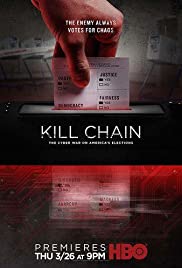
KILL CHAIN: THE CYBER WAR ON AMERICA'S ELECTIONS
US, 2020, 91 minutes, Colour.
Directed by Simon Ardizzone, Russell Michaels, Sarah Teale.
This is a topical HBO documentary for 2020.
There has been talk for more than 20 years about the possibility for hacking into computers, especially those used for elections and voting, this came to a head during and after the 2016 American elections, especially the into investigation into Russian hacking, the attack on Hillary Clinton…
In fact, the central investigator in this film, the Finnish expert, Harry Hursti, made a film criticising the Diebold industries in 2005 with the company trying to get the film banned. There is information here that some of the machines that were under critique at the time were still being used by 2018, some of them in prospect for the 2020 elections.
This is a documentary that would foster the fears of so many people that elections can be hacked, rigged.
Harry Hursti, from Finland and seen there discussing his precocious abilities with his mother, remembering his interventions and inventions while still a child and a teenager. He spends a great deal of his time in the United States, showing the possibilities for hacking and illustrating it with alarming results, being on hand during various elections in the US, especially that of the governor of Georgia in 2018. He is a persuasive witness to illustrate the ease with which hackers can develop their methods and have access to all kinds of information, and the possibility of altering the information.
There are a number of other experts seen as talking heads in the film, especially another friend from Finland. There are also a number of North American experts as well as journalists who investigated hacking.
There are some political commentators, representative Senator from the Republicans as well as representative Senator from the Democrats.
While this kind of expose can be alarming for the general public, the documentary was badly received by more conservative audiences, especially those who place Donald Trump on a pedestal, decrying the film as conspiracy theory.
As with some stories about conspiracy theories, and some of the films from directors like Michael Moore, if only half the material presented proved to be true, this is still very alarming.
Published in Movie Reviews
Published in
Movie Reviews
Saturday, 09 October 2021 13:01
Missing Evidence
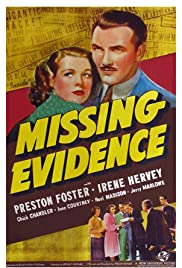
MISSING EVIDENCE
US, 1939, 64 minutes, Black and white.
Preston Foster, Irene Hervey, Inez Courtenay, Chick Chandler, Noel Madison.
Directed by Phil Rosen.
A small-budget second feature from Universal Studios. Preston Foster (Last Days of Pompeii) appeared in a number of these, a solid leading man. The leading lady is Irene Hervey who had a long career both in film and on television. The director is Phil Rosen, who worked with Edison in filming The Miracle Man in 1912, began direction in 1915, prolific in small-budget features, his career cut short by his death in 1951.
In many ways, this is a routine FBI investigation, undercover. Interestingly, the focus of attention is on the selling of sweepstake tickets, being outlawed by the government yet manufactured falsely in the United States, imported from overseas, defrauding gullible customers.
Preston Foster is the investigator, Irene Hervey being an agent of sales at a prestigious hotel. She is part of the link between the big bosses, the printing of the tickets, their distribution by small time agents. She and her friend are taken in by the FBI fobbing off all accusations. The old elevator man at the hotel buys a ticket and finds he has the winning number, only to receive a telegram indicating that the ticket was fake. He shoots himself. This changes the attitude of those working in the hotel and they go to the FBI agent, leading to their all infiltrating the company distributing the tickets. They are all directed by a boss who keeps saying that he is in connection with Mr Big, Noel Madison.
There are criminal connections, guns and fights, timing and expose – and Linda working for the boss who reveals, as they make their escape in a car, intending to sale overseas, that he is the Mr Big. There is a car crash, death, and vindication of the infiltration and expose.
Published in Movie Reviews
Published in
Movie Reviews
Saturday, 09 October 2021 13:01
Jil-ho: The Dawning Revenge
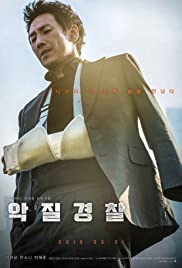
JO PIL-HO: THE DAWNING RAGE
Korea, 2019, 127 minutes, Colour.
Sun-kyun Lee, So-nee Jeon.
Directed by Jeon-beom Lee.
The original Korean title was Bad Police.
This is a typical Korean violent police thriller, highlighting business corruption. It has a great deal of action, from bank robberies, to exploding factories, to violent torture.
The central character is a corrupt policeman, organising the robbing of banks with a colleague, stashing his money, planning the robbery of a factory – but it explodes, killing his companion. While he is still on the force, he is involved in the investigation about the fire.
Jo Pil-ho is not a particularly sympathetic character, initially smug and cruel, depending on his wife for support, somewhat cynical in his action and investigation. However, as the film proceeds, he becomes more sympathetic, finding a young girl who has stolen his money in order to get finance for a friends surgery. He is also pursued by the henchmen of the corporate boss as well is his corrupt lawyer.
This leads to a lot of confrontations, chases, fights. Eventually, the policeman befriends the young girl (who has a very loud and confrontative mouth), leading back to her taking the money, his supporting her against the torture and interrogations, her insulting her captors and then leaping to her death.
The policeman also falls from the building, but recovers, makes a 3-D printed gun, goes to the headquarters of the corrupt boss, confronting him. The boss then is to make an address about his philanthropy to education. The policeman is almost killed several times but uses his wits, especially when he is covered in tub filled with water but managed to extricate the plug and survive. Eventually, he kills the lawyer, goes on stage and kills the boss while he himself is shot.
The final scene shows him surviving and remembering the young girl.
Published in Movie Reviews
Published in
Movie Reviews
Saturday, 09 October 2021 13:01
Born to Gamble

BORN TO GAMBLE
US, 1935, 63 minutes, Black-and-white.
Onslow Stevens, H.B. Warner, Maxine Doyle, Eric Linden, Lois Wilson, William Janney, Ben Alexander.
Directed by Phil Rosen.
This is a brief drama, with quite a number of subplot elements, made in the atmosphere of the Depression, a moral fable about contemporary American society, risk-taking in gambling, preoccupation with making money, using a movie story to make its point. The director is Phil Rosen, who worked with Edison in filming The Miracle Man in 1912, began direction in 1915, prolific in small-budget features, his career cut short by his death in 1951.
There is an opening declaring that risk-taking in gambling is prevalent amongst the wealthy as well as the poor.
The framework of the story is a group of wealthy men meeting in a club, one of them, Carter Matthews, played by H.B. Warner eight years after his being the King of Kings, warning the others about gambling. They were having an argument about the causes of depression and prepared to bet on who was right and who was wrong. Matthews intervenes and then tells the story of his family.
This leads the audience back to a rather wild West, the portrait of a gambler, eminently successful, continually lucky, yet drawing three aces of spades in succession, a premonition of death. A drunken rival confronts him, angry about losing money, a challenge to a duel, guns in the streets, both men dying.
Carter Matthews marries his daughter, is prosperous in a piano selling firm, has several children. There are several moral lessons from the behaviour of his children. They are shown as children being risktakers in gambling in the vein of their grandfather. The oldest son is restless, enjoys flying, enrols in the Lafayette Escadrille, is to sail on the Lusitania and loses his life. The other sons are involved in business, one of them persuaded by the other to get involved in bootlegging, and an assassination by a local gangster. The other son, Henry (played by Onslow Stevens who also played the gambling grandfather) is a champion sportsman, rather reticent, hesitating in his proposal to marry a young woman. With the death of his brother, he disappears, the audience finding that he plans to kill the gambler but is patient and wants to set him up, ruining him financially, but by appearing as an expert on horseracing, fixing a race, ingratiating himself with the gambler, spending seven years building up his empire and then giving him false advice. But, the gangster is shot at the time and Henry arrested.
There is a court case, testimony, Henry found not guilty – reunited with his father, and marrying the young woman.
Quite an amount of moralising, anti-gambling, in just over an hour.
Published in Movie Reviews
Published in
Movie Reviews
Saturday, 09 October 2021 13:01
Never Say Never Again
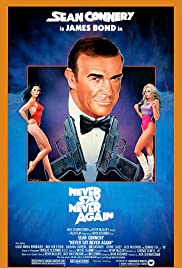
NEVER A NEVER AGAIN
1983, 134 minutes, Colour.
Sean Connery, Klaas Maria Brando are, Max von Sydow, Barbara Carrera, Kim Basson Jack, Bernie Casey, Alec Mc Cowan, Edward Fox, Rowan Atkinson.
Directed by Irvin Kershner.
After filming Diamonds are Forever, 1971, Sean Connery is quoted as saying that he would never play James Bond again. The title of this film, 12 years later, plays on his remarks. However, by this time, Roger Moore had taken over as 007 and this is a surprise film, coming from outside the company formed by the Broccolis to form the whole series.
This is a remake of Thunderball, Sean Connery repeating his role, with Max von Sydow as Blofeld (with his cat) and the organisation of SPECTRE. However, the villain of the piece, involved in stealing bombs from the Americans is Largo, Klaus Maria Brandauer (who had recently appeared in the Oscar-winning Mephisto). The plan is complicated, as always, bombs cleverly stolen and stored, one threatening Washington.
At the opening, Bond is involved in a military exercise, rather violent, and is the subject of criticism by a very crotchety M, Edward Fox, quite in contrast to Bernard Lee and Judi Dench. There is a cameo by Alec Mc Cowan as Q. When the bombs are stolen, Bond is involved in enforced exercise and dietary regime but is sent on mission, travelling to the Bahamas to track down the villain, meeting up with his American counterpart, Felix Leiter (Bernie Casey), and discovering Largo and his relationship with Domino, the brother of the American naval officer who was involved in the stealing of the bombs There is a comic performance from Rowan Atkinson in his Blackadder days.
The action moves to the south of France, Bond encountering Largo, fending off the attempts to kill him by Fatima Blush (Barbara Carreiro) one of the SPECTRE Council.
In retrospect, Bond seems rather sexist in his relationships with the women, casual and incidental, though, as with the previous films, seeming to find true love at the end, this time with Domino, Kim Basinger.
Not a great James bond film, but it was directed by Irvin Kershner immediately after his great success with The Empire Strikes Back.
1. Sean Connery’s declaration about never playing James Bond again? 12 years later?
2. A remake of Thunderball? Adaptation of the plot? Characters?
3. The settings, London, official offices, M, Q and headquarters, the clinic, the Bahamas, the South of France? Underwater action? The musical score?
4. The history of James Bond? Sean Connery’s history? Now in his 50s? The opening, the attack on the enemy, violence and death, his being stabbed? M and his criticisms, a military exercise? M and his character, disapproving, sending Bond to the clinic, the comedy of his regime, exercise, meals, his special case of luxuries?
5. Bond himself, self-sufficient, his relationship with women? The background of the treatment of women? Objects? Characters in themselves? The worker at the resort? Fathima and the seduction? The woman in the Bahamas? The encounter with Domino, deeper feelings, the ending?
6. The introduction of SPECTRE, the re-introduction of Blofeld? Max von Sydow and his style? His pet cat? The underground headquarters, the members of the committee? Fatima and her arrival? The link with Largo? The prospect of stealing the bombs?
7. Largo, self-confident, his boat, relationship with Domino? The plan for the bombs? His skills, his team? The scientist? The bombs and their flight, disappearing, underwater, his sailing from the Bahamas, the south of France, Palmyra, the setting up of the bomb underwater? The other bomb in Washington?
8. The plan with the naval officer, addicted to heroin, the false eye, the eye of the president, his pass, setting up the bomb, his relationship with Fatima, the drive away, the snake in the car, his crash? Domino as his sister? Eventually wanting revenge?
9. M sending Bond on mission, the encounter with Q and the various gadgets – and there later use? Going to the Bahamas, Fatima seeing him, the discussion with the woman going fishing? Fatima and the sexual encounter? Her attempts to kill Bond? His going to the woman’s room, the explosion? Getting the information from the local agent, Largo going to France? Meeting up with Felix? Their working together? Are murdering the local agent?
10. The south of France, the encounter with Domino, the attraction, the sequence of the dance, his giving her the information about her brother? Largo, his watching Domino and her dancing, his infatuation? The gift of the necklace? Its having the map? Bond and the meeting with Largo, the taunting, Fatima’s failed attempt, her pursuit, with the gun, his pen and her exploding? Arousing Largo’s suspicions of Domino? Africa, Bonds getting the message to headquarters, tied up but escaping with the watch, rescuing Domino on the horse, her being at auction, the tribesman, the pursuit, jumping from the cliff?
11. The pursuit of Largo, the scuba diving, Bond and Felix, the tactics, the confrontations, the battles, the bomb, Largo and his success – and failure? Domino and the confrontation?
12. The usual ending, Bond and Domino – but no more Sean Connery as Bond?
Published in Movie Reviews
Published in
Movie Reviews
Saturday, 09 October 2021 13:01
Same Kind of Different as Me
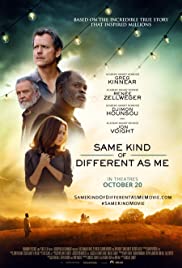
SAME KIND OF DIFFERENT AS ME
US, 2017, 119 minutes, Colour.
Greg Kinnear, René Zellweger, Djimon Hounsou, Jon Voight, Olivia Holt, Geraldine Singer.
Directed by Michael Carney.
As the title indicates, this is about human similarities and differences, in the context of American society, black and white. In fact, the words of the title are spoken by the central black character, Denver Moore (Djimon Hounsou), at the funeral of his white friend, a woman he admired and who had asked that he speak at her funeral, Debbie Hall (René Zellweger). His friend is Ron Hall ( Greg Kinnear).
This is the kind of film that gets the label “inspirational�. And so it is. However, it is not a fiction. It is based on the story of the three central characters, actual characters from Texas. In the event, Denver and Ron collaborate on a book about their stories, their tentative meetings, the growing friendship, all in the context of a soup kitchen and the outreach to the homeless. After they completed the book, they toured the United States, a speaking tour, a fundraising tour, donations which were in the millions.
At first the film seems to be the story of Ron, an art dealer, driving to stay with an artist friend to write a book. Then it goes back two years. Ron seems to be something of a celebrity, happily married to Debbie, two children. Then we find that he has been unfaithful to her, his lover urging him to tell the truth to his wife, his doing so, her dismay, her ringing the lover to say that she forgave her, forgiving her husband.
In some ways, Debbie seems too good to be true. But she is good. She works diligently at the soup kitchen, getting Ron, who is rather reluctant as might be imagined, to help her with the serving. One of the clients of the soup kitchen is an irascible man, causing a lot of disruptions, seemingly absorbed in himself and his woes. This is Denver Moore.
In fact, the story of Ron and Debbie seems rather matter-of-fact all things considered. And so the film veers towards the story of Denver himself, Ron making some outreaches towards him, Denver gradually being accepting, and Denver then telling his stories, taking the audience and Ron into his past through flashbacks.
The audience is taken back to the cotton fields, the world of slavery, Denver as a boy, living in poverty, as an adolescent, working in the cotton fields, his desire to run away, discovering the wonders of town life which amazed him, but his bad decision, an attempted robbery, years in prison.
While Denver admires Debbie, he comes to like Ron, who gets him some better clothes, and even takes him to an art gallery where he makes astute comments on Picasso.
This also sadness in the film, but an atmosphere of joy and triumph at Debbie’s funeral, the applause at Denver’s speech (a standing ovation, even including Ron’s quite bigoted alcoholic father, played with quite some aggression by Jon Voight).
This is a film for ordinary cinemagoers who are prepared to welcome a story of good people, their struggles, triumph over evil. It has a high profile central cast. (But some audiences, especially some critics, don’t have an appetite for seeing goodness in film, preferring more dramatic conflicts between good and evil.)
There are photos of the two men in the final credits – and a clip of the actual Denver speaking on tour.
1. The title and its tone? As spoken at Debbie’s funeral by Denver? Indications of themes, human equality, issues of racism and prejudice? Issues of the repercussions on individuals?
2. An inspirational film? Based on actual characters and events? Ron Hall and Denver Moore writing the book, that to, lectures, raising money for the homeless?
3. The Texas settings, homes, the poorer areas of the city, the refuge and engines, the forests, the surrounding countryside? The flashbacks to the past, poverty, the cotton fields, the small towns, prejudice, prisons and harshness? The musical score? The songs?
4. The initial focus on Ron, his voice-over, art dealer, intending to write a book, visiting the artist, the conversations, the paintings?
5. The initial flashback, two years earlier, shows Ron and his life, the dealings, the social, his liaison, the woman threatening to tell his wife? The scene of telling his wife, the tension between the two, possibilities for reconciliation, Debbie, her stances, ringing the woman and forgiving her, giving her husband a second chance? Her strong character? His weaker character, the challenge to be better? His admitting the wrongs? And the lack of intimacy between them after so many years of marriage? The presence of the two children?
6. Debbie, her work in the soup kitchen, demanding that Ron join her, his excuses, his coming, serving the meals? Debbie and her personal approach to those lining up? Ron and his mixed reactions? The children working there?
7. The introduction to Denver, Denver’s story taking centre role? An older man, strong presence, his angers, upturning the tables? His defiance? His concern about others? Living alone, across the road and out the back?
8. Debbie and the outreach, Ron and his beginning jn outreach, trying to talk with Denver, the rejections, Ron bringing him the food? The gradual breaking down barriers? Denver more willing to come to the centre?
9. Denver, the flashbacks, the harshness of his life as a boy, family, the cotton fields? His growing older? Harsh life continuing? His decision to run away, literally, going to the town, amazed at the town and the traffic, the police, trying to rob the bus, his arrest, prison, the long years in the harsh prison? The effect of telling his story? His embarrassment, shame and regrets?
10. Ron listening, the effect on him, more sympathetic, sharing the meals? The clothes and suits? His taking Denver to the gallery, the discussion about the Picasso and Denver’s perceptions? Debbie inviting Denver into the house, Ron’s reactions? Breakfast? Denver’s reaction to the house? The breaking down barriers?
11. Debbie and Ron, the development of the relationship? Debbie religious? Ron saying he was not religious? Denver a believer, God making treasure out of trash?
12. Ron and his relationship with his father, his father’s drinking, boorish manner, driving around the property, the meals, his father’s rudeness? Taking Denver to the meal, Earl and his bigotry?
13. Debbie, in all, the collapse, the diagnosis, the treatment? Ron and his support, the children? Ron taking the whole family and Denver to see his father, Earl’s dismissal of Debbie’s illness? Ron severing ties with his father?
14. Debbie, the illness, the setting up of the dance floor and their dancing? Denver and his care for Debbie?
15. Debbie’s death, the funeral, Denver leading the procession, the homeless men and the flowers on the coffin? The announcement that Debbie wanted Denver to speak at her funeral? The heartfelt speech, “same kind of difference as me�, Debbie’s impact on Denver? The congregation standing and applauding?
16. Denver telling Ron that there was one thing he had to do, Ron going to see his father, the reconciliation?
17. Ron, going to the artist to write the book, his return home? The subsequent history, he and Denver and the book, the tour with the talks, the raising of millions of dollars for the homeless?
18. The photos of the two men and their tours? And the clip of the actual Denver and his speech?
19. The impact of such an inspirational films?
Published in Movie Reviews
Published in
Movie Reviews
Saturday, 09 October 2021 13:01
Agatha Christie's Poirot How Does Your Garden Grow
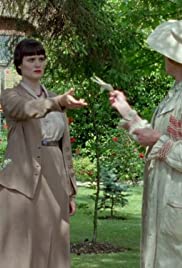
HOW DOES YOUR GARDEN GROW
UK, 1991, 50 minutes, Colour.
David Suchet, Hugh Fraser, Philip Jackson, Pauline Moran, Anne Stellybrass, Tim Wylton, Marjorie Mason, Catherine Russell, Peter Birch, Ralph Nossek.
Directed by Brian Farnham.
This is a short story in the television series of Agatha Christie mysteries with David Suchet as Poirot. It takes its title from the nursery rhyme, Mary, Mary… Which, of course, is an alert for the audience to discover who is the quite contrary Mary in this story.
At the opening, Poirot is present at the Chelsea Flower Show where a Pink Rose is named after him. There he encounters an elderly woman in a wheelchair who gives him a seed packet for stocks. He is puzzled, intends to visit her, only to find that she is dead.
There is also an opening at the Russian Embassy in London, and an introduction to a young woman with an official. She is then seen to be the companion of the dead woman. And, it emerges that she is to inherit the fortune of the dead woman. Also in the house are relatives, husband and wife, her name Mary. There is also the doctor who cares for the elderly woman.
Poirot attends the Flower Show with Hastings but Hastings has an allergy, continually sneezing, so Miss Lemon accompanies Poirot on his investigations. Chief Inspector Japp attends the Flower Show, knowledgeably, and becomes involved in the solution of the murder, the main suspect being the young woman with the Russian connection, who has many icons in her room, and has taken refuge in the Russian church.
There is a mystery as to how the elderly woman was poisoned, but the clue is in the garden, not cockles but oyster shells, Miss Lemon visiting a fishmonger to get evidence which leads to Mary, buying oysters, giving them to the elderly later lady as a secret treat, and administering the poison through these. And the mystery of the empty seed packet – a hint at stocks, because Mary was speculating with the dead woman’s money.
Mary attempts to kill herself with weedkiller – but the audience knows that her alcoholic husband conceals his whiskey in that bottle! But a romantic ending with the young Russian woman United with the official from the Embassy.
1. The popularity of Agatha Christie mysteries? The television series? With David Suchet as Poirot?
2. The British setting, London and Poirot’s flat, office? The Chelsea Flower Show? The visit to the home? Exteriors and interiors? The beauty of the garden? The Russian Embassy? The musical score?
3. The Russian background, the flags, the Embassy, images of Stalin, commentary about the Soviet Union? Katrina and her visit? The discussions with Nikolai? Audience suspicions?
4. Poirot and the Pink Rose, his being pleased, getting dressed, the scent, Hastings and his sneezing? The presentation of the rose in his name? The media? At the show, the encounter with Amelia Barrowby, her giving him the seed packet, the discussion? His puzzle, the empty packet?
5. The decision to visit Miss Barrowby will come in, leaving Hasting behind with his allergy, Miss Lemon and accompanying him?
6. The audience seeing Miss Barraby, old, impatient, demanding? Katrina as the heir? The Delafontaines in the house, Mary and the garden, the mail and her hiding the letter, her alcoholic husband? The doctor and his care? The meal? Miss Barrowby and her illness, her seizure, her death? Katrina running away?
7. Katrina, Russian, the icons in her room, her devotion? Poirot going to the Russian church and finding her?
8. Poirot and the visit, the silver bell in the garden, the shells? The discovery that Miss Barrowby had died? The discussion with Mary, with her husband? With the doctor? The strychnine?
9. The mystery of how the poison had been administered? The discussions with the doctor? Suspicions on Katrina?
10. Chief Inspector Japp, his presence of the flower show, knowledgeable about flowers? The surveillance of the house? The police in disguise? Japp later upbraiding them? His suspicions about Kristina, a clear solution?
11. Poirot, the nurse rhyme, silver bells and shells, Miss Lemmon and her visit to the fishmonger? Miss Barrowby secretly eating the oysters?
12. The confrontation in the garden, Mary welcoming, the tables turned, the clue about the seed packet, the flowers, stocks, the revelation of Mary’s speculation on the stock market, her resentment that Katrina was to inherit all the money in the house – and the garden? Miss Barrowby wanting to see the lawyer, to change her will, the note under threat?
13. The revelation of the truth, Mary and her attempt to escape, the police surrounding, her drinking the weedkiller – and the audience knowing that it was whiskey that her husband was drinking?
14. The romantic ending, Katrina and Nikolai together? The solution about Hastings’ allergy, the scent that Poirot used? And his smile of self-satisfaction?
Published in Movie Reviews
Published in
Movie Reviews
Saturday, 09 October 2021 13:01
Agatha Christie's Poirot Sad Cypress
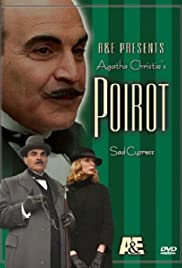
SAD CYPRESS
UK, 2003, 93 minutes, Colour.
David Suchet, Elizabeth Dermot Walsh, Rupert Penry- Jones, Kelly Reilly, Paul Mc Gann, Phyllis Logan, Marion O' Dwyer, Diana Quick, Stuart Laing, Jack Galloway.
Directed by David Moore.
Sad Cypress is a Shakespearean reference to death. This is a full-length feature in the television series of Agatha Christie murder mysteries with David Suchet as Poirot.
It is a later production and so he is not accompanied by Captain Hastings or Miss Lemon. The substitute in this story is a doctor, friend of Poirot from the past, a chess-playing companion. He is played by Paul Mc Gann.
However, the film opens in a court, a grim woman in the dock, talking about feeling vengeful. She is found guilty of murder and to be hanged. She is played by Elizabeth Dermot Walsh, Eleanor, whom we see at the beginning of the film engaged to Roddy, Rupert Penry- Jones. They have received a mysterious letter warning them about her dead aunt’s will. They bring the letter to Poirot who sees it as quite a vengeful letter and goes down to the house of the woman who will be murdered, Diana Quick.
The elderly woman is dying, is attended by housekeeper, by the doctor, by two nurses – and by young woman, Mary (Kelly Reilly in an early role), the daughter of the gardener, his education has been financed by the elderly lady. There is concern about her health and about her dying.
She dies without a will and therefore the niece will inherit. But Eleanor and Roddy have fallen out because of Mary. In the aftermath of the death, Eleanor has Mary and Nurse Hopkins (Phyllis Logan) who is helping with sorting clothes and other things to lunch – after which Mary is found dead on a couch.
The solution to the mystery involves photos from the past, a mysterious outsider at the time of the death, suspicions on Eleanor, on Roddy. However, Poirot is able to sort out what has happened in the past concerning the dead woman and Mary, her illegitimate daughter, who would inherit everything instead of Eleanor. Mary has made her will in favour of an aunt in New Zealand. And the solution, Nurse Hopkins who has figured prominently in the story, is in fact the aunt that Mary has never seen and therefore is to inherit Mary’s money from her birth mother.
With only a few days to go before being executed, Eleanor is liberated from prison – and met by her effort-devoted doctor friend.
1. The popularity of Agatha Christie mysteries? This adaptation of her novel, part of the television series with David Suchet as Poirot?
2. The setting, costumes and decor, 1937 (and the news of the death of George Gershwin), Poirot’s office? Courts in prison? The mansion, interiors and exteriors? The grounds? The musical score?
3. The title, the Shakespeare reference, death?
4. The opening, Eleanor Carlyle in the court, her voice-over and commentary, her face, impassive? The prosecutor, the condemnation, criticism of her, no remorse? Poirot in the court? The judge, the jury’s verdict of guilty, condemned to death? The audience assuming that she was the killer?
5. The action in flashback? The introduction to Eleanor and Roddy? Their friendship from the past, the relationship, engaged? Roddy going to Europe? Eleanor and her concern, the letter and the warning?
6. Roddy and Eleanor, their concern, going to visit Mrs Welman, Eleanor’s aunt? The household, the housekeeper, the nurses, Hopkins and O’ Brien? The presence of Mary? Memories of the past, with Eleanor and Roddy? Mrs Welman play paying her education fees? Mary returning from Germany, in the household? The background of her father and the garden? Teddy and his attentions to her?
7. Poirot, his reputation, wanting cases? Eleanor and Roddy, the note, their concern, consulting him? His explanation about the forcefulness of the note, the pressure of the writing? His sense of foreboding, the visit to the house?
8. The relationship between Roddy and Eleanor, from the past, his immediate attraction to Mary? Eleanor’s reaction? Her seeing them kissing? Her feeling vengeful? Yet her exterior calm manner?
9. Mary, her personality, in town, the encounter with Poirot and his warning to her, her devotion to Mrs Welman, in her sick room, keeping vigil? The aftermath of the death? Sorting out? The lunch, the sandwiches, her death?
10. Eleanor, her aunt, concern, her aunt’s illness, moods, death? Her not having any will? The doctor’s explanation? Eleanor inheriting everything? The discussions with Roddy, his going to France? Eleanor feeling vengeful, buying the fish paste, the issue of food poisoning? Making the sandwiches, the special sandwiches for Mary? Nurse Hopkins present, sharing the lunch? Making the tea? The discovery of Mary dead?
11. The presence of the doctor, the past friendship with Poirot, his being the Hastings equivalent? His care for Mrs Welman, medication? His devotion to Eleanor? The discussions with Poirot?
12. Poirot, his visit, presence in the house, the death, the local police?
13. Suspicions with Nurse O’ Brien, in the lift, her suspicions of Eleanor? Poirot later questioning her?
14. The prominence of nurse Hopkins, her caring concern? With Mary?
15. Poirot, Nurse O’ Brien and the photo, Mrs Welman of the baby? The correspondence? Mrs Welman saying the name of Louis as she died? The revelation of the story, Mrs Welman and Louis, his being married, the birth of Mary, her being entrusted to the couple, being brought up, and the aunt in New Zealand?
16. Mary, the possibility of her inheriting rather than Eleanor? The daughter? Her having made a will, in favour of the aunt in New Zealand?
17. Poirot, the final revelation, Nurse Hopkins as the aunt from New Zealand? Her sister looking after Mary? Nurse Hopkins’ plan, the poison in the tea, Poirot’s pretence that he had been poisoned, the revelation of the truth? Mary not knowing who Nurse Hopkins was? But Nurse Hopkins as the aunt to inherit the fortune?
18. The police, the doctor, the revelation of the truth? Eleanor in prison, preparing for death? Her being freed? And the doctor ever devoted to her?
Published in Movie Reviews
Published in
Movie Reviews